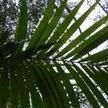Kostas - from my own experience, RPW are likewise attracted to Washingtonias, hence they would probably infest any number of species, given the option. The mistake I made was trimming off a few leaves in early May, which put them onto the scent. My neighbour lost a Washingtonia and a Date Palm a few months ago. His Washingtonia blew over in the wind, although the trunk remained in the ground so maybe RPW had been burrowing away inside. When they cut down his Date Palm I noticed a dead, adult weevil laying on the stump a few days later. Both trees went within weeks of each other. The P. dactylifera had been losing it's crown for some time, but the Washingtonia looked as healthy as ever, but obviously the trunk had been weakened. You've probably seen this photo before, but here they both were last year:

